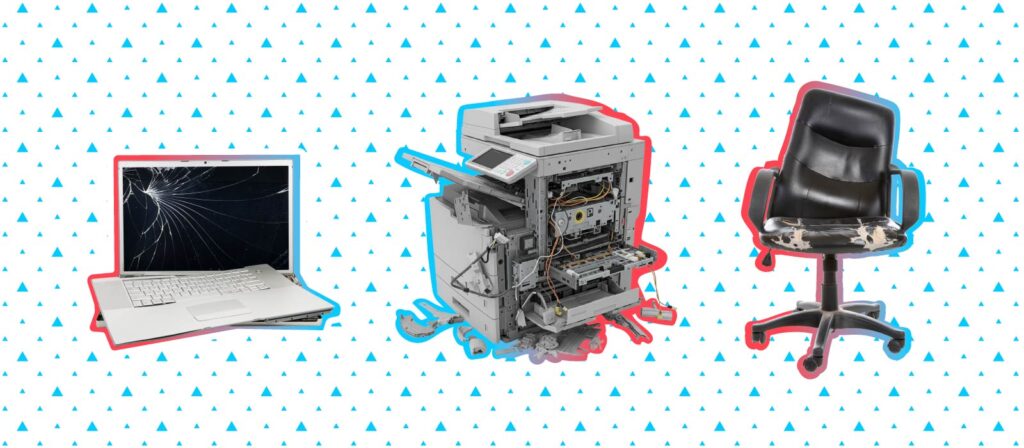Enterprise facility management is a necessary tool for any large organization, especially those that operate across multiple locations. Without it, business operations can get unwieldy fast, wasting time and money and creating unnecessary headaches.
In this article, we explore enterprise facility management and its benefits, including a roundup of software solutions that can simplify it at any level.
What is enterprise facility management?
Enterprise facility management refers to the systems that large organizations—i.e.: enterprises—put in place to manage business operations, facility operations, employees, assets, and workflows across multiple offices and/or locations.
In other words, it’s facility management, expanded to serve the needs of more than one facility.
This means that beyond standard facility management services, managers in the enterprise space are often tasked with more complex real estate management as well.
It also means they need complex facilities management solutions—and the right software—to successfully maintain business processes.

What are the main tasks of facilities management?
The main role of facility management has always been to streamline and optimize daily operations of a building and/or office space. In addition, the role works to improve employee experience and ensure workers have the tools they need to do their jobs well.
Real estate portfolio management teams responsible for enterprise facilities simply have a more involved task on their hands. They need to coordinate extended and often expanding networks of locations.
Specifically, enterprise facilities management providers are responsible for the following workplace solutions.
Improving space utilization
Improving space utilization is a primary task for any facilities manager (FM), no matter what the size of their organization. The larger the real estate portfolio, the more crucial it is to ensure that space is being divvied up among employees and assets in the most effective way possible.
To do this well across multiple workspaces, FMs need to be able to understand metrics. Metrics can include things like cost per employee, occupancy, and current and projected vacancy. When armed with the right information, they can improve how their organization is using their space. This, in turn, can lead to cost savings. Additionally, it can lead to a more optimized working environment that can support a variety of flexible working arrangements.
Simplifying move management
Move management is an FM task that can be greatly complicated by having multiple locations. It’s one thing to shift an employee or two from one desk or even one floor to another. Moving dozens or even hundreds of employees across various buildings is inherently more challenging.
That’s why, as we’ll cover below, those responsible for enterprise facility management can benefit from software solutions that simplify moves, such as interactive floor plans and visual move data.
This is how Rapid7, a global leader in cybersecurity, seamlessly relocated 600 employees over one weekend.
“We used Scenarios to place employees in potential seats as we received the seating arrangements from department heads and team managers,” says Andrea Diieso, Workplace Experience Manager at Rapid7, of their nearly effortless move. “It was really helpful to have a ‘rough draft’ to play around with.”
Simplifying work orders
It’s also much easier to put in a request for a floor above you, versus for a facility the next town over.
That’s why enterprise facility management teams need to ensure work orders and other order processes are easy.
“Unless you have the right system in place, sending requests to facilities can be a tedious process for employees,” says Scott Moitoza, Senior Director of Real-Estate and Facilities, Procore. “Being able to submit and track facility requests quickly—just by typing /request into Slack—has been a game-changer for everyone in our company.”
Planning expansions
Growth for enterprise organizations can often mean physical expansions. This adds in more and more layers of complexity that need to be managed well.
That’s because without good leadership and planning that comes from the enterprise management level, increasing corporate real estate holdings can lead to a mismatch of different systems and software solutions that can actually hurt the long term viability of an organization.
Supporting employees
Like we’ve mentioned, employee experience is a key focus in facilities management.
No matter what the size of an organization, this will typically include offering robust and real-time desk booking and meeting room booking options.
Of course, this can again be complicated by having desks and conference rooms spread out among more than one office space or building. The more FMs are able to streamline these processes across locations, the easier it will be for employees to navigate their office and find the right spaces to do their work.
Supporting the hybrid office
Given that more and more companies are embracing hybrid work—in large part because more and more employees are demanding it—enterprise facility management now has to account for this new reality as well.
This means ensuring that employees at all locations have the tools they need. This is no matter what hybrid work model their enterprise is using.
In fact, given the current growth of hybrid working, the new reality for most organizations and FMs is that they need to support workers in a variety of locations. Even if those locations are simply employees’ kitchen tables and a rotating array of coffee shops.
In this sense, the hybrid office requires similarly complex solutions as an enterprise office does. This means both require a modern integrated workplace management system (IWMS) software solution. And both FMs and employees must be able to access it from anywhere.
Providing asset management
It’s simple math: more buildings equal more assets.
Again, enterprise asset management (EAM) is simply a more complex version of ‘regular’ asset management. It should include preventative maintenance, maintenance management, upgrades, procurement, and tracking the lifecycle and maintenance costs of key systems like energy use and HVAC.
Ensuring long term sustainability
Most companies now place environmental sustainability among their top concerns. Enterprise facility management solutions therefore need to be ‘green’ as well.
This can look like improving space utilization, like we’ve covered. Cutting back on real estate is a sure-fire way to reduce your carbon footprint.
Supporting a hybrid workforce can also lead to carbon reductions, since it can dramatically cut back on the time people spend commuting (and therefore clogging up the air and the expressways).
The enterprise facilities management team is also often in the best position to implement other energy management systems. This can improve long term environmental stewardship. Especially when they collaborate with IT and HR teams to have a full picture of what’s happening.
Collecting the right data for decision making
Good data is at the heart of every good decision, and therefore at the heart of every successful enterprise.
When software for an enterprise facilities management system also collects reports and analytics data, this can help make better solutions for ongoing viability.
“It’s incredibly important for me to be able to check the density of each of our offices in real-time—what’s occupied, what isn’t—because I’m not able to be in every location. So when I have a question like “What’s the situation in Tokyo?,” I can go to OfficeSpace and get the answer in seconds.”
Bernard Morrissey, Chief Officer for Real Estate and Facilities K&L Gates

Is enterprise facilities management necessary for your organization?
Given a rapidly complex, competitive, and high-tech business environment, good facility management is essential for any organization. Especially for those with numerous locations and hundreds or thousands of employees.
In other words, every enterprise needs enterprise facilities management.
That said, any organization or enterprise considering whether codified facilities management is necessary for their organization should ask themselves the following questions:
- Are you tracking metrics that are critical to the workplace?
- Are you able to understand and use these metrics to make better decisions?
- Is it easy for all employees to engage with the office and manage requests?
- Can you support a hybrid workforce?
- Do you have the data and tools you need to improve your space utilization?
- Would it be easy to incorporate a new facility into your current portfolio?
If the answer to any of these questions is ‘no,’ then it’s time to consider a better solution for your facility management.
Should you outsource enterprise facility management?
We’re currently seeing what the CBRE calls an ‘outsourcing evolution’ in facility management services. The organization is predicting the industry to grow to $1 trillion by 2025.
Many organizations believe that outsourcing facility management is the more cost effective and reliable option. And for some, that may be the case.
But managing all the key aspects of an enterprise facility in-house will usually simplify project management and streamline services. Additionally, it should keep key analytics and data in the hands of those primed to maximize it.
For these reasons, enterprises may want to consider hiring a full time facility manager or management team. They may be more invested in their long term success than an outside provider. This makes them more cost effective choice in the long run.
They can also offset additional staffing costs by choosing a robust but user-friendly software solution that can break up duties among existing team members.

What is enterprise facilities management software?
Enterprises facilities management software is the complete software system that monitors, organizes, and optimizes facility operations across more than one building or location. Ideally, it will be accessible on a single platform that integrates with IWMS software an organization is already using.
What are the benefits of facility management software?
Thankfully, the days of big, archaic, and clunky facility management software are behind us.
Modern IWMS is a simple solution that covers everything from health and safety and occupancy reports to helping employees figure out where their office neighborhood is sitting today.
Provided this software offers real estate metrics that can handle a large portfolio, companies can use it to keep even enterprise-level facility management in-house.
What should facility management software include?
The needs of real estate portfolio managers at the enterprise level can be summed up in one word: automation. Anyone managing multiple locations needs real-time, accurate data at their fingertips—all with the click of a button.
That means critical data should be accessible from the same place that stores lease agreements, notes, images, and other documentation, and that it should be easy to normalize lease costs.
It also means enterprise FMs should have ready access to high-level portfolio data such as maximum capacity and current capacity.
Specifically, facility management software must include four key features to work for any size enterprise:
- Portfolio reports, which provide all relevant real estate data and ultimately help to maximize the real estate budget
- Stack plans, which are floor plans that can be used to better plan to reorganize even complex portfolios
- Scenario planning, which makes it easier to test out changes virtually before making any physical changes to the office
- Reports and analytics which cover all critical workplace metrics like occupancy and allocation
Moreover, all these features need to be accessible from the same cloud-based platform and mobile app that manages both the built workplace environment, as well as the now ubiquitous digital workspace.
“Before we launched OfficeSpace internally, we didn’t have visibility into who sat where, and there was no way to track when people moved. We needed more accountability, better data, and accurate reporting to keep up with Shopify’s rapid growth.”
Alicia Murrell, Workplace Experience Manager, Shopify

What is the main task of facilities management at the enterprise level?
The main task of facilities management at the enterprise level is the same as it is at any level. It is to find a workplace solution that suits every worker in every location, while also keeping the business running smoothly.
This means having all real estate, facility and employee needs met on one easy-to-use platform. It must also collects and synthesize the data necessary to make better decisions down the line.
OfficeSpace provides facility management software that can handle any sized portfolio. Reach out for a free demo.
Photos: Venti Views, Berkeley Communications, Karolina Grabowska, Anna Shvets, energepic.com




